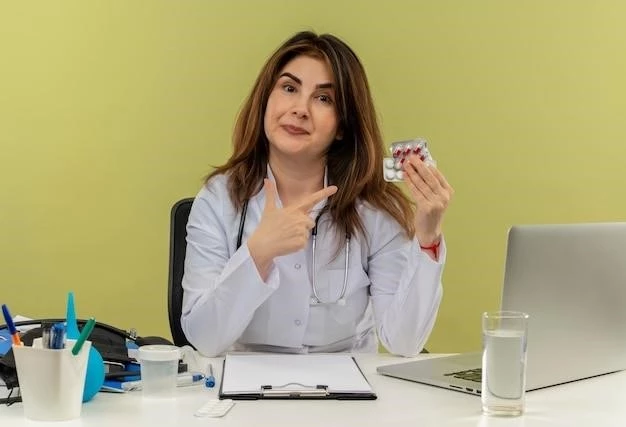Solifenacin is commonly used to relieve symptoms of overactive bladder, such as frequent urination, urgency, and incontinence. It works by relaxing the bladder muscles, reducing involuntary contractions.
Uses of Solifenacin in Treating Overactive Bladder
Solifenacin, commonly known by the brand name Vesicare, is a medication prescribed to treat symptoms of overactive bladder. Overactive bladder is a condition characterized by a sudden urge to urinate, frequent urination, and incontinence. Solifenacin helps alleviate these symptoms by relaxing the muscles of the bladder and reducing the sudden, uncontrollable contractions that lead to urgency and leakage.
Doctors may recommend solifenacin for individuals struggling with overactive bladder issues that impact their daily activities and quality of life. This medication can help increase bladder capacity, decrease the frequency of urination, and reduce episodes of urgency and incontinence.
It is essential to follow your healthcare provider’s instructions regarding the use of solifenacin for optimal results. This medication is usually taken orally in the form of a tablet, with or without food, once a day. It is crucial to take solifenacin at the same time each day to maintain consistent levels of the drug in your system.
Solifenacin should be taken whole and not crushed, chewed, or broken. In case you miss a dose, take it as soon as you remember unless it is close to the time for your next scheduled dose. Do not double dose to make up for a missed one. If unsure about how to proceed, consult your healthcare provider;
It is important to give solifenacin time to work effectively in your system. Consistency in taking the medication as prescribed is key to experiencing the full benefits. If you have any concerns about the effectiveness of solifenacin or experience bothersome side effects, discuss them with your healthcare provider for guidance on potential adjustments to your treatment plan.
Side Effects of Solifenacin and How to Manage Them
While solifenacin is an effective medication for treating overactive bladder, like any other medication, it may cause side effects in some individuals. It is essential to be aware of potential side effects and know how to manage them appropriately.
Common side effects of solifenacin may include dry mouth, constipation, blurred vision, dry eyes, dizziness, and mild stomach discomfort. These side effects are usually mild and temporary, but if they persist or worsen, it is crucial to inform your healthcare provider.
If you experience dry mouth while taking solifenacin, try sucking on ice chips, chewing sugarless gum, or drinking water frequently to keep your mouth moist. For constipation, ensure you are consuming an adequate amount of fiber in your diet, staying hydrated, and being physically active.
Blurred vision and dry eyes can be managed by using lubricating eye drops or seeking advice from an eye care professional. If you feel dizzy, avoid sudden movements and practice caution when standing up from a sitting or lying position.
If you encounter severe side effects such as difficulty urinating, severe stomach pain, or signs of allergic reactions like rash, itching, swelling, or difficulty breathing, seek immediate medical attention.
It is essential to inform your healthcare provider about all the medications, supplements, and herbal products you are currently taking to avoid potential interactions. Certain medications, such as antifungal drugs, antibiotics, and antiviral medications, may interact with solifenacin, affecting its effectiveness or increasing the risk of side effects.
Always follow your healthcare provider’s dosage instructions when taking solifenacin to ensure its optimal effectiveness in managing your overactive bladder symptoms. Avoid adjusting your dosage or stopping the medication without consulting your healthcare provider first.
By being aware of potential side effects, managing them appropriately, and staying informed about interactions with other medications, you can use solifenacin safely and effectively in treating your overactive bladder symptoms.
Interactions of Solifenacin with Other Medications
Understanding potential interactions between solifenacin and other medications is crucial to ensure the safe and effective treatment of overactive bladder. It is important to inform your healthcare provider about all the medications, supplements, and herbal products you are currently taking to prevent any adverse effects or reduced effectiveness.
Solifenacin may interact with certain medications, altering how it works in your body or increasing the risk of side effects. Some medications that may interact with solifenacin include antibiotics like clarithromycin and erythromycin, antifungal medications such as ketoconazole and itraconazole, and antiviral drugs like ritonavir.

Additionally, the use of certain medications for conditions like hypertension, mental health disorders, and gastrointestinal issues may also interact with solifenacin. It is important to provide your healthcare provider with a comprehensive list of all your medications, including prescription and over-the-counter drugs, before starting solifenacin.
Drug interactions can lead to adverse effects or reduced effectiveness of solifenacin in managing overactive bladder symptoms. Your healthcare provider may need to adjust your dosage, change the timing of your medications, or monitor you more closely for potential interactions.
If you have concerns about potential interactions between solifenacin and other medications you are taking, do not hesitate to discuss these concerns with your healthcare provider. They can provide guidance on how to manage or minimize any risks associated with drug interactions while ensuring you receive the maximum benefits from your overactive bladder treatment.
Dosage Information for Solifenacin
When it comes to the dosage of solifenacin for treating overactive bladder, it is crucial to follow your healthcare provider’s recommendations carefully. The prescribed dosage will depend on your individual medical condition, response to treatment, and any other medications you may be taking.
Typically, solifenacin is taken once daily, with or without food. It is important to take the medication at the same time each day to maintain consistent levels in your body and maximize its effectiveness in managing overactive bladder symptoms.
The usual starting dose of solifenacin is 5 mg daily٫ which may be adjusted by your healthcare provider based on your response to the treatment; In some cases٫ the dose may be increased to 10 mg daily if necessary. However٫ it is important not to exceed the prescribed dose unless directed by your healthcare provider.
If you miss a dose of solifenacin, take it as soon as you remember. However, if it is near the time of your next scheduled dose, skip the missed dose and resume your regular dosing schedule. Do not double the dose to catch up.
It is essential to avoid crushing, chewing, or breaking the solifenacin tablets, as they should be taken whole. If you have difficulty swallowing the tablet, speak to your healthcare provider about potential alternative formulations or methods of administration.
If you believe that the prescribed dosage of solifenacin is not providing adequate relief from your overactive bladder symptoms or if you experience any intolerable side effects, do not adjust the dosage on your own. Instead, consult your healthcare provider for a proper evaluation and consideration of potential dosage adjustments.
Effectiveness of Solifenacin in Treating Urinary Symptoms
Solifenacin has been found to be effective in treating urinary symptoms associated with overactive bladder. By targeting the underlying cause of overactive bladder – involuntary bladder muscle contractions – solifenacin helps alleviate bothersome urinary symptoms such as urgency, frequency, and incontinence.
Studies have shown that solifenacin can significantly reduce the number of daily episodes of urgency, urinary frequency, and incontinence compared to a placebo. Many individuals who have used solifenacin to manage their overactive bladder symptoms have reported improvements in their quality of life and an enhanced ability to engage in daily activities without disruptions caused by sudden urges to urinate.
The effectiveness of solifenacin in treating urinary symptoms may vary from person to person. Factors such as the severity of the symptoms, individual response to the medication, and adherence to the prescribed dosage regimen can influence the overall effectiveness of solifenacin in managing overactive bladder.
It is important to work closely with your healthcare provider to monitor the effectiveness of solifenacin in addressing your urinary symptoms. Keeping track of any changes in your symptoms, side effects experienced, and overall quality of life can help your healthcare provider make informed decisions about the continuation or adjustment of your treatment plan.
If you find that solifenacin is not providing the desired relief from your overactive bladder symptoms or if you have concerns about its effectiveness, do not hesitate to discuss these issues with your healthcare provider. They may recommend adjustments to your dosage, lifestyle modifications, or additional interventions to optimize the management of your overactive bladder.
Safety Precautions for Using Solifenacin
When using solifenacin for the treatment of overactive bladder, it is essential to prioritize safety by following specific precautions to ensure the medication’s effectiveness and minimize potential risks.
First and foremost, inform your healthcare provider about any existing medical conditions, allergies, or medications you are taking before starting solifenacin. This information will help your healthcare provider determine if solifenacin is safe for you and prevent any adverse reactions or interactions.
It is important to adhere to the prescribed dosage of solifenacin and not exceed the recommended amount without consulting your healthcare provider. Taking higher doses of solifenacin than prescribed can increase the risk of side effects and may not provide additional benefits in managing overactive bladder symptoms.
If you experience severe side effects or allergic reactions while taking solifenacin, such as difficulty breathing, rash, swelling, or chest pain, seek immediate medical attention and discontinue the medication until further guidance from your healthcare provider.
While using solifenacin, avoid consuming grapefruit or grapefruit juice, as it may interact with the medication and affect its absorption in the body. Additionally, limit alcohol consumption, as alcohol can worsen certain side effects of solifenacin such as dizziness and drowsiness.
If you are pregnant, planning to become pregnant, or breastfeeding, consult your healthcare provider before using solifenacin to ensure the safety of the medication for you and your baby. It is essential to weigh the potential benefits of solifenacin against any potential risks to make an informed decision.
Regularly monitor your response to solifenacin and communicate any concerns or changes in your symptoms to your healthcare provider. By staying vigilant about your health and adhering to safety precautions, you can use solifenacin effectively and manage overactive bladder with confidence.
Storage Guidelines for Solifenacin
Proper storage of solifenacin is essential to maintain its stability and effectiveness for treating overactive bladder. Follow these guidelines to ensure the quality of your medication⁚
- Store solifenacin at room temperature away from moisture and heat.
- Avoid exposing the medication to light, and keep it in its original packaging until ready to use.
- Do not transfer solifenacin to a different container unless instructed by your pharmacist.
- Keep solifenacin out of reach of children and pets to prevent accidental ingestion.
- Check the expiration date on the packaging and do not use solifenacin if it has expired.
If you have any unused or expired solifenacin tablets, dispose of them properly according to local guidelines or take them to a pharmacy for safe disposal. Do not flush medications down the toilet or discard them in household trash unless specifically instructed to do so.
By following these storage guidelines, you can ensure that your solifenacin remains potent and safe for use in managing your overactive bladder symptoms. Proper storage practices help maintain the integrity of the medication, allowing you to benefit from its therapeutic effects when needed.
